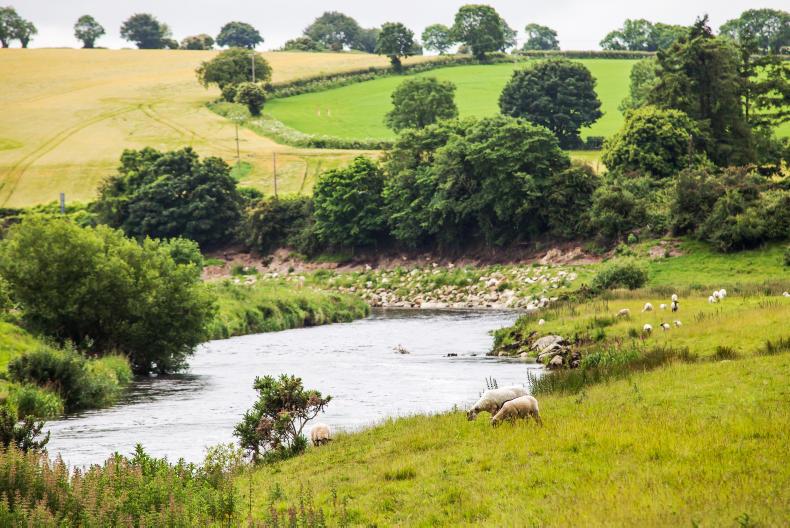The quality of our surface waters has remained relatively static since 2007 to 2009 and improvements, planned for under the first river basin management cycle, have not been achieved, according to the Environmental Protection Agency (EPA).
It found that nationally, 91% of groundwater bodies, 57% of rivers, 46% of lakes, 31% of transitional (estuarine) waters and 79% of coastal waters are achieving either good or high status under the Water Framework Directive (WFD).
Meanwhile, the reduction in the level of seriously polluted waters has continued, with only six river water bodies assigned bad status under the Water Framework Directive in 2010–2015 compared with 19 from 2007 to 2009.
Pesticides and herbicides
The level of pollution from hazardous substances is low, although some pesticides and herbicides, including Mecoprop, MCPA and 2,4-D, have been detected by the EPA at low levels in a significant number of rivers during routine monitoring.
There are approximately 350 ‘‘active substances’’ approved for use in Ireland, of which many are plant protection products or biocides.
From 2013 to 2015, an analysis focused on the screening of 14 substances totalling 9,464 measurements. None of the pesticide substances monitored exceeded their annual average EQS (where applicable) during that period.
Overall, there were 395 samples with pesticide detections (4.2%) affecting 72 of the 85 rivers assessed.
MCPA was the most widely observed substance, detected in almost two-thirds of all rivers surveyed.
Glyphosate was detected in 5% of the rivers surveyed.
Fish kills
The EPA highlights that there has been an increase in the number of reported fish kills, with 97 reported between 2013 and 2015, an increase of 27 on the number reported between 2007 and 2009.
The reason for this increase is unclear, but it may be a result of extended dry spells and/or flooding events, rather than a return to an increase in the number of serious pollution spills that would have been the main cause of fish kills in the past.
Figures from Inland Fisheries Ireland show that between 2013 and 2015, 23% of fish kills were caused by agricultural practices.
Human activities
The EPA has been undertaking an assessment of the effect of human activities on the water environment over the past three years.
Nutrient losses from agriculture and domestic wastewater discharges are the primary reasons why the water quality objectives of the WFD will not be met.
In relation to agriculture, the EPA said that the pressures relate to diffuse nutrient run-off (phosphorus and nitrogen) and sediment from land, and point source pollution associated with farmyards.
Read more
Farmers asked to avoid water pollution when making silage and spreading slurry
Rosderra Meats and Tipp Co-op named on EPA priority list
The quality of our surface waters has remained relatively static since 2007 to 2009 and improvements, planned for under the first river basin management cycle, have not been achieved, according to the Environmental Protection Agency (EPA).
It found that nationally, 91% of groundwater bodies, 57% of rivers, 46% of lakes, 31% of transitional (estuarine) waters and 79% of coastal waters are achieving either good or high status under the Water Framework Directive (WFD).
Meanwhile, the reduction in the level of seriously polluted waters has continued, with only six river water bodies assigned bad status under the Water Framework Directive in 2010–2015 compared with 19 from 2007 to 2009.
Pesticides and herbicides
The level of pollution from hazardous substances is low, although some pesticides and herbicides, including Mecoprop, MCPA and 2,4-D, have been detected by the EPA at low levels in a significant number of rivers during routine monitoring.
There are approximately 350 ‘‘active substances’’ approved for use in Ireland, of which many are plant protection products or biocides.
From 2013 to 2015, an analysis focused on the screening of 14 substances totalling 9,464 measurements. None of the pesticide substances monitored exceeded their annual average EQS (where applicable) during that period.
Overall, there were 395 samples with pesticide detections (4.2%) affecting 72 of the 85 rivers assessed.
MCPA was the most widely observed substance, detected in almost two-thirds of all rivers surveyed.
Glyphosate was detected in 5% of the rivers surveyed.
Fish kills
The EPA highlights that there has been an increase in the number of reported fish kills, with 97 reported between 2013 and 2015, an increase of 27 on the number reported between 2007 and 2009.
The reason for this increase is unclear, but it may be a result of extended dry spells and/or flooding events, rather than a return to an increase in the number of serious pollution spills that would have been the main cause of fish kills in the past.
Figures from Inland Fisheries Ireland show that between 2013 and 2015, 23% of fish kills were caused by agricultural practices.
Human activities
The EPA has been undertaking an assessment of the effect of human activities on the water environment over the past three years.
Nutrient losses from agriculture and domestic wastewater discharges are the primary reasons why the water quality objectives of the WFD will not be met.
In relation to agriculture, the EPA said that the pressures relate to diffuse nutrient run-off (phosphorus and nitrogen) and sediment from land, and point source pollution associated with farmyards.
Read more
Farmers asked to avoid water pollution when making silage and spreading slurry
Rosderra Meats and Tipp Co-op named on EPA priority list





SHARING OPTIONS